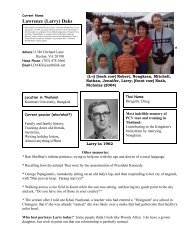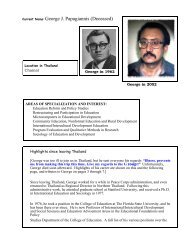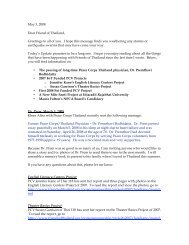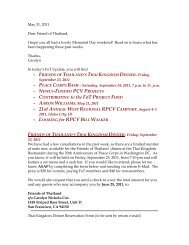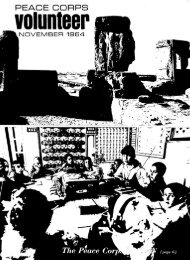PEACE CORPS
Peace Corps Volunteer â January 1966 - Peace Corps Online
Peace Corps Volunteer â January 1966 - Peace Corps Online
- No tags were found...
Create successful ePaper yourself
Turn your PDF publications into a flip-book with our unique Google optimized e-Paper software.
Report measures PCV tmpact<br />
The Cornell Pem Report is the sto~<br />
of 50 Peace Corps Volunteem and<br />
what they accomplished—and didn’t<br />
accomplish—in the Andes.<br />
It is also a story of 15 villages and<br />
what happened to them because of the<br />
Peace Corps,<br />
The r=earchers, who were well acquainted<br />
with community life in the<br />
Andes long before the Peace Corps<br />
arrived, carefully measured every aspect<br />
of Volunteer life over a period<br />
of two years, 1962-64.<br />
The Volunteem were under a social<br />
science microscope from tbe time they<br />
entered training for Peru 111 in the<br />
summer of 1962 to the time they completed<br />
sewice, and the communities<br />
where they labored were assessed before,<br />
during, and after their tours.<br />
The result is a detailed and scholarly<br />
329-page work titled “Measurement of<br />
Peace Corps Program Impact in the<br />
Peruvian Andes. ”<br />
A major conclusion of the report<br />
is that Peace Corps communities<br />
developed at a rate almost three<br />
tire= s f~t as communities without<br />
Volunteem,<br />
The revert finti that “the Peace<br />
Corps pr;gram in tbe Peruvian Andes<br />
did achieve a memurable impact upon<br />
i~ target communities the Volunteers<br />
fulfilled one of tbe three missions<br />
defined for the Peace CoIps by tbe<br />
Congress in establishing tbe organization,<br />
by contributing to the development<br />
of a critical country in the South<br />
American re~on that is one key to the<br />
future course of world history.”<br />
The research project was contracted<br />
by the Peace Corps to the Department<br />
of Anthropology at Cornell University.<br />
The anthropologists had long<br />
been familiar with many of the Indian<br />
villages in the Peruvian Andes through<br />
their Corne!l Peru Proiect which began<br />
I4 years ago. ‘<br />
Dr. AlIan R. Holmberg, chairman<br />
of the Department and one of tbe<br />
three authors of the repofl, w% the<br />
architect of the community development<br />
proflam in VicOs, Pem (see<br />
Page 10), which became famous<br />
throughout btin America.<br />
The contract representatives were<br />
involved from the be~nting of the<br />
Peace Corps project not only as o~<br />
sewers but as staff advisers and consultant<br />
to the Peace Corps country<br />
staff and to Volunteers themselves.<br />
Their “participant obsewation” involved<br />
detailed research through interviewing,<br />
personal obsewation, use of<br />
questionnaires, and photography.<br />
Holmberg and four other members of<br />
the faculty and staff at Cornell were<br />
assisted hy a large staff of Peruvians,<br />
including many anthropology students,<br />
who did extensive field investigation.<br />
Frank Mantiewicz, Latin America<br />
Regional Director, calls the report<br />
a “landmark in community development<br />
research.<br />
“The 50 Volunteers<br />
were among the<br />
In the Andean village of Pisac, Molly Heit teaches children to embroider tapestries, using their own ideas for design.



